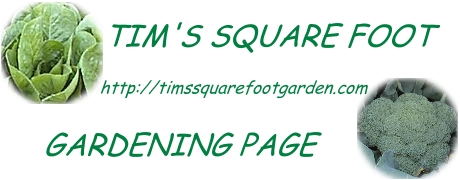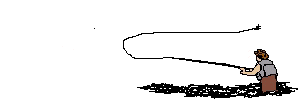
"A weed is a plant that has mastered every survival skill except for learning how to grow in rows."
Doug Larson
A few of my web site visitors have asked that I publish a basic seed starting and planting calendar. Please note that this is the approximate schedule that I use for my garden, which is located in USDA Zone 5. Your garden might be located in a different zone than mine, but this guide should be useful to all gardeners no matter where you live. For those new gardeners as well as for those more seasoned, I cannot stress enough the importance of keeping notes on when you started or planted seeds and how well different varieties performed. It does not require any involved writing, but just some simple note taking is all that is needed. Over time you should be able to “fine tune” your plan to maximize your garden successes and to minimize your garden failures. The one thing that you cannot control is the weather, which makes gardening a challenge at times. For those new gardeners, start small and do not get discouraged with a few failures. Learn from them and move on. With gardening, there is always another crop and another year.
Wishing You Success and Happiness in Your Garden.
Your Web Host,
Tim Beckman
![]()
![]()
![]()
![]()
![]()
![]()
![]()
Note: The seeds that are started indoors are allowed to germinate indoors and then moved immediately out to the cold frame.
Mid to late February:
- Put together cold frame and place it onto an area of the garden where warm weather crops will be grown. This will allow time for all seedlings to fully mature in the cold frame before removal.
Last week in February or first week in March:
- Start seeds of lettuce indoors. Exact date will vary depending on the weather.
- When weather permits, empty both compost bins and place about a 1 to 2 inch layer of compost over all garden beds.
First or second week of March:
- Start seeds of celery, cabbage, broccoli, and brussel sprouts indoors.
Third week in March:
- Start seeds of peppers, and tomatoes indoors.
First week in April:
- Onion seedlings/slips arrive via mail and are planted directly out into the garden.
- Transplant lettuce seedlings out into the garden under hoop house if the seedlings are big enough. They are usually big enough when they just start to get their second set of true leaves.
Second week in April:
- Continue to transplant lettuce seedlings out into the garden under the hoop when they get big enough.
- Plant pea seeds directly out into the garden
Third week in April:
- Transplant broccoli, cabbage, and brussel sprout seedlings out into the garden.
- Start seeds of cucumbers in cold frame.
- Plant certified seed potatoes out into the garden.
Fourth week in April:
- Transplant tomato and pepper seedlings into bigger pots.
- Start more heat tolerant lettuce seeds indoors like butter head and romaine varieties.
First Week in May:
- Start harvesting a few of the small leaves on your early planted lettuce.
- Start harvesting green onions, if large enough. Harvest about half of the topsetting onions for green onions before the plants get too big.
- Start a few more heat tolerant lettuce seed varieties outside on the covered back porch.
- Transplant celery seedlings out into the garden
- Plant corn seeds directly out into the garden.
Second week in May:
- Take apart cold frame and put away until next spring.
- Transplant pepper, tomato, and cucumber seedlings out into the garden.
- Plant seeds of bush green beans and pole lima beans directly out into the garden.
Wow, take a break and start harvesting all of those fresh vegetables!!

Third or fourth week in June:
- Pull up the garden peas and replant with bush green beans.
First week in July:
- Start seeds of fall broccoli, cabbage, and cauliflower on covered back porch.
- Not much else to do in the garden so I am Going Fishing!!

Second week in July:
- Pull up cucumber vines. By this time the cucumbers are finished producing, for the most part. This seems to help out the pepper plants that are growing in close proximately.
Third week in July:
- If the majority of the onion plant tops have fallen over, pull them up and clip the tops off and let them dry/cure for about 10 days on screens over the garden plot where they were grown.
- Pull up walking/egyptian top setting onions and clip tops and/or bottom bulbs and allow to dry until October.
First week in August:
- Plant bush green beans seeds directly into the garden where the spring planted onions grew.
- Transplant out into the garden the broccoli, cabbage, and cauliflower seedlings. Make sure to keep these seedlings well
watered!!
- Plant carrot seeds directly out into the garden. Keep seed bed shaded, if possible, and well watered.
Second or third week in August:
- Plant bush green bean seeds into corn plot when corn is finished.
- Start seeds of fall lettuce on the covered back porch
Take a break!! Tomato and pepper plants should be producing a nice harvest about now!! Enjoy the lazy late summer
afternoons. You will find me fishing a lot this time of year.
First or second week in September:
- Transplant lettuce seedlings out into the garden. Make sure to keep these seedlings well watered!!
Month of October:
- Keep a row cover handy to keep frost off of late planted beans.
- Keep the carrot and lettuce plots covered with hoops to keep them growing throughout the fall. Harvest the lettuce as needed.
- As heavy frost approaches, cover broccoli, cabbage, and cauliflower plants. This keeps the plants actively growing until harvest.
- Around the third or fourth week in October, pull up the pepper plants and replant the area with topsetting onion tops that have been drying since late July. New green growth should be visible from these onions in about 2 to 3 weeks.
Month of November:
- Cover all unused garden areas with 2 to 3 inches of shredded tree leaves.
- After first hard freeze, cover topsetting onions with a thin layer of shredded tree leaves.
- Start harvesting carrots when they mature. Mulch the carrot bed with a 1-inch layer of shredded tree leaves.
Month of December:
- Finish harvesting lettuce. If the weather stays relatively warm, expect to harvest lettuce nearly all the way through December.
- Finish harvesting the carrots. In past years, I have harvested carrots into early January.
Now, take about two months off. Use this time to plan for next year’s garden. Make sure to order your seeds early enough to have them in time to start your spring garden.
All Content © Copyright 2002-2022 Tim's Square Foot Gardening